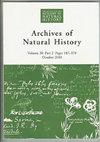美国探险队的海洋哺乳动物,1838-1842:历史和分类学
IF 0.3
4区 哲学
Q3 HISTORY & PHILOSOPHY OF SCIENCE
引用次数: 0
摘要
1838-1842年的美国探险在某种程度上代表了美国海洋哺乳动物生物学的开端。探险队带回了至少12种海洋哺乳动物标本(主要是小型鲸目动物或鳍足动物)的信息,其中7种当时被认为是新物种。在查尔斯·威尔克斯中尉的指挥下,这次探险行程超过8万英里,勘测了新的水域和陆地,带回了数千个科学标本。Titian Peale和John Cassin的官方出版物涵盖了收集到的鸟类和哺乳动物。该中队的出版物以及军官和科学家的期刊也包含了大量关于海洋哺乳动物目击的信息。他们特别感兴趣的是捕鲸作业和捕鲸地,这次探险对扩大美国在全球的捕鲸前景做出了很大贡献,重点是南太平洋岛屿。尽管今天基本上被遗忘了,但“美国战争”。在建立美国在海洋哺乳动物生物学和全球捕鲸行动方面的影响力方面,s.ex Ex扮演了重要的早期角色。本文章由计算机程序翻译,如有差异,请以英文原文为准。
Marine mammals of the United States Exploring Expedition, 1838–1842: history and taxonomy
The United States Exploring Expedition of 1838–1842, in some ways, represents the beginning of American marine mammal biology. The expedition returned home with information on at least twelve marine mammal specimens (mostly small cetaceans or pinnipeds), seven of which were considered new species at the time. Commanded by Lieutenant Charles Wilkes, the expedition covered over 80,000 miles, surveyed new waters and lands, and brought back thousands of scientific specimens. Official publications of the expedition by Titian Peale and John Cassin cover the birds and mammals collected. The squadron’s publications, and the journals of its officers and scientists also contain a good deal of information about sightings of marine mammals. Of particular interest were whaling operations and grounds, and the expedition did much to help expand the whaling prospects of the United States around the globe, with a focus on the South Pacific islands. Though largely forgotten today, the “U. S. Ex. Ex.” played an important early role in establishing American influence in marine mammal biology and global whaling operations.
求助全文
通过发布文献求助,成功后即可免费获取论文全文。
去求助
来源期刊

Archives of Natural History
HISTORY & PHILOSOPHY OF SCIENCE-
CiteScore
0.40
自引率
50.00%
发文量
34
审稿时长
>12 weeks
期刊介绍:
Archives of Natural History (formerly the Journal of the Society for the Bibliography of Natural History) publishes peer-reviewed papers on the history and bibliography of natural history in its broadest sense, and in all periods and all cultures. This is taken to include botany, general biology, geology, palaeontology and zoology, the lives of naturalists, their publications, correspondence and collections, and the institutions and societies to which they belong. Bibliographical papers concerned with the study of rare books, manuscripts and illustrative material, and analytical and enumerative bibliographies are also published.
 求助内容:
求助内容: 应助结果提醒方式:
应助结果提醒方式:


